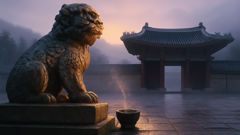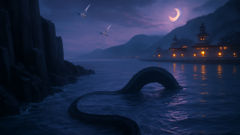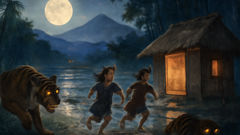Introduction
In the southernmost reaches of Chile, where the land splinters into countless islands and the Pacific’s breath coils thick with salt and fog, there exists a world like no other. The Chiloé Archipelago rises from the water, cloaked in evergreen forests and encircled by a sea that is as generous as it is treacherous. For generations, the people of Chiloé have lived between two realms: one foot rooted firmly on rain-soaked earth, the other stepping into the realm of myth. Here, the boundary between what is seen and what is believed is as mutable as the tides. As the sun sinks behind the cloud-laced peaks of the Andes, and the first stars cast trembling reflections across the waves, the stories begin to stir. Among all the legends whispered around hearths and carried by the wind, none is as haunting or as enduring as that of the Caleuche—the ghost ship said to glide silently through the night, gathering the souls of those claimed by the sea. Some say it gleams like a vision, its deck alight with music and laughter, while others insist it is a shadowy omen, a vessel of sorrow and unfinished fates. Fishermen avert their eyes when night falls and a strange glow ripples across the horizon, for they know what might come sailing through the mists. The legend of the Caleuche is more than a tale; it is the heart of Chiloé’s relationship with the ocean, a story born of tragedy, hope, and the unbreakable bond between the living and those lost to the deep. To follow its course is to slip into a world where magic lingers on every shore, and where the voices of the drowned still call out to those who listen.
Chapter I: Whispers on the Tides
On the island of Chiloé, where the ocean carves inlets deep into the mossy heart of the land, the villagers live in tune with the shifting moods of the sea. In the fishing hamlet of Curaco de Vélez, the days are governed by tides and weather. Children gather limpets from rocks at low tide, women weave baskets from quilineja vines, and men mend nets while watching the horizon with wary eyes. It’s a land where every tree has a spirit, and every stone remembers footsteps. Superstition is woven into daily life like a subtle thread. The elders speak of the Trauco who dwells in the shadowed woods, and the bruja who can transform into birds. Yet no story chills the marrow quite like that of the Caleuche.
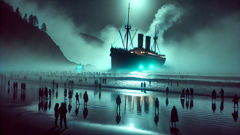
In the evenings, as fog pours from the sea and cloaks the hills, families huddle around the warmth of peat fires. The old ones tell of a night when the village fisherman Tomás lost his brother Ignacio to a sudden storm. The brothers had set out before dawn, their boat laden with crab traps and hope. By nightfall, only Tomás returned, his face gray with salt and grief. That same night, as villagers searched the beaches by torchlight, a glow appeared offshore—a ship, unfamiliar and impossible, sailing where no ship should be. It shimmered with an unnatural radiance, lanterns burning blue and green. Music, both sweet and sorrowful, drifted on the wind. Some saw figures dancing on its deck, their faces both familiar and strange. Ignacio’s name was whispered, and Tomás fell to his knees, for he believed he saw his brother among them.
From that night on, the story of the Caleuche spread like wildfire. The elders said it was a ghost ship, commanded by a crew of drowned souls. Others believed it to be a living ship, a magical being that could sail above and below the water. Some said that brujos—sorcerers—were its true masters, steering it through fog and night, gathering spirits lost at sea. As weeks passed, more sightings were reported: a fisherman glimpsed the vessel through a break in the mist; a child found footprints on a deserted shore, glowing faintly blue at dawn. The village lived in fear and awe. They learned to leave gifts of shellfish and cider on the beach at night, in hopes that the Caleuche would pass them by. Yet, for Tomás, the wound never healed. He waited at the water’s edge each night, searching for another glimpse of his brother or a chance to speak with those aboard.
A year later, as autumn rains fell harder and the sea grew restless, a stranger arrived in Curaco de Vélez. She was a woman with silver hair and eyes as deep as the ocean. She called herself Mariela and claimed to be a healer from distant Quinchao. She listened to Tomás’s story with quiet sympathy. “Some ships,” she said, “sail not for the living but for the lost. The Caleuche is not a curse, but a bridge.” Mariela began to walk the beaches at dusk, humming old songs. Soon, she became part of the village’s rhythm. One night, she told Tomás, “The sea takes what it will, but sometimes, it gives back—if you’re brave enough to ask.”
Guided by Mariela, Tomás prepared an offering. He carved a small boat from driftwood and filled it with rosemary and sea glass. Together, they launched it into the surf at midnight. The waves accepted their gift, and a silence settled over the shore. Then, from the far-off mist, came a soft glow, and the sound of music—a violin, sweet and piercing. For a moment, Tomás saw figures on the water, arms raised in farewell or greeting. The Caleuche drifted past, silent except for the music, and Tomás felt a warmth in his chest. He did not see his brother, but he felt his presence, as real as the wind. From that night forward, he no longer feared the ship. Instead, he began to believe that the souls aboard were not lost but transformed, sailing eternally between worlds.
Chapter II: The Brujos and the Pact of the Deep
The Caleuche’s legend wound itself deeper into Chiloé’s soul as years passed. Children recited its name in games, and fishermen painted protective eyes on their boats. Yet, beneath the stories lay questions no one dared ask aloud: Who commanded the Caleuche? Why did some see loved ones aboard while others saw only shadows?
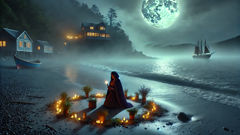
The elders whispered of the brujos—sorcerers who had made a secret pact with the sea. It was said they held the power to summon the Caleuche, steering it through fog and tempest. The brujos, living in hidden cabins among the cypress groves, moved unseen among the people. They healed the sick, brought rain in drought, and—some claimed—could raise the dead. But their powers came at a cost: loyalty to the ocean and to the ship that sailed its midnight waters.
Mariela, who had become beloved in Curaco de Vélez, was rumored to be a bruja herself. She was seen talking to seabirds at dawn and gathering rare herbs from cliffs where no one else dared climb. One stormy night, she confided in Tomás: “The Caleuche is not just a ship. It’s a sanctuary for those who died with longing in their hearts—for home, for justice, for love. The brujos keep its secrets and honor its crew.”
She told him the story of Don Baltazar, the first brujo to board the Caleuche. As a young man, Baltazar had lost his family to a tidal wave. He devoted his life to mastering the island’s magic, seeking a way to speak to the dead. One night, as he performed a ritual at the water’s edge, the Caleuche appeared. The ship’s captain—a woman whose eyes shimmered with moonlight—invited him aboard. There, he found not horror but peace. The crew welcomed him with music and laughter, their faces alight with joy. They told him that every soul lost at sea became part of the ship, forever voyaging between the world of the living and that of spirits.
Baltazar returned to land with new wisdom. He taught his people that the ocean’s gifts and losses must be accepted in equal measure. In time, Baltazar disappeared—some say he sails still, a master among the Caleuche’s ghostly crew. Mariela’s voice softened as she finished her tale: “To command the Caleuche is to accept both joy and sorrow, to honor what the sea takes and what it returns.”
One summer night, a tragedy struck Curaco de Vélez. A fishing boat vanished during a sudden storm. Three were lost, including a young mother named Inés. Grief swallowed the village. As days passed, her children began to dream of their mother smiling aboard a radiant ship. Mariela gathered the villagers and led them to the shore. Together, they lit lanterns and sang old songs. As fog rolled in, the Caleuche appeared once more, its decks aglow with otherworldly light. Inés stood at the rail, waving farewell—her sorrow transformed into serenity. The villagers wept and rejoiced, knowing she was at peace.
From that night on, the legend of the brujos and the Caleuche was no longer a source of fear but of comfort. The islanders accepted that the ship was not an omen of doom but a sign that the spirits of the lost had found their way home. Mariela remained, guiding her neighbors through sorrow and change, always with one ear tuned to the music that echoed across the midnight sea.
Conclusion
The legend of the Caleuche endures because it holds so many truths—about grief, hope, and the mysteries of the sea. On Chiloé, where storms can take without warning and the night seems endless, the people found solace in the notion that loss is not an end but a transformation. Each sighting of the ghost ship became an affirmation that the spirits of those claimed by the ocean were not forsaken but cherished and remembered. Through rituals led by healers like Mariela and stories carried by wind and water, the islanders learned to honor both absence and presence. The Caleuche is more than a tale of fear; it is a promise that even in darkness, music and laughter can be heard if you listen closely enough. And so, when the fog rolls in thick and the waves whisper against the stones, hearts on Chiloé turn not only to sorrow but to wonder—trusting that somewhere out on the shifting tides, the Caleuche sails on, gathering all those lost into a luminous embrace that bridges two worlds.








